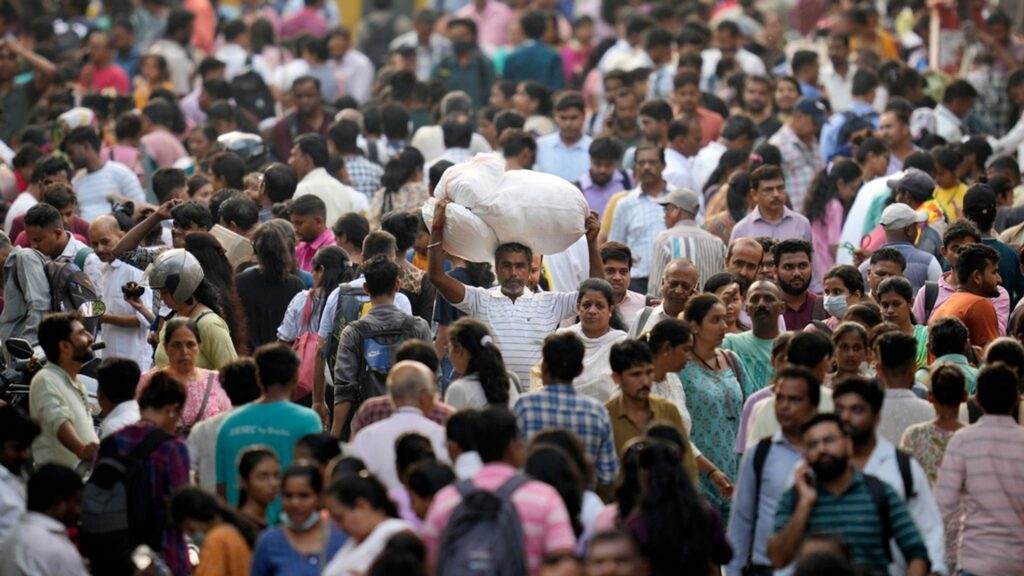The United Nations Population Fund’s (UNFPA) State of World Population – 2024 report, titled “Interwoven Lives, Threads of Hope: Ending Inequalities in Sexual and Reproductive Health and Rights,” revealed that India’s population is projected to double in 77 years.
Overview of India’s Population Dynamics
Population Estimates:
- India’s population is currently estimated at 1.44 billion, positioning it as the most populous nation globally, ahead of China’s 1.425 billion.
- The population has seen substantial growth from 1.21 billion during the 2011 census.
Age Distribution:
- Approximately 24% of the population is aged between 0-14 years.
- The segment aged 10-24 years constitutes 26% of the population.
- Those aged between 15-64 years represent 68%, while 7% are aged 65 years and above.
Life Expectancy:
- The average life expectancy is 71 years for men and 74 years for women.
Fertility rate:
- Women in the reproductive age group (15 to 49 years old) currently have a Total Fertility Rate (TFR) of 2.0, which is below the replacement level of 2.1.
- The replacement level is the point at which a population has the exact number of births to replace itself from one generation to the next.
Health and Social Challenges
Sexual and Reproductive Health:
- There have been significant advancements in sexual and reproductive health over the past 30 years, though these have often overlooked the most marginalized communities.
- Notable progress includes a reduction in maternal mortality, which now accounts for 8% of the global total, due to enhanced maternal health services’ accessibility.
Child Marriage:
- The prevalence of child marriage in India was recorded at 23% between 2006-2023.
Maternal Mortality:
- Despite national improvements, disparities in maternal mortality rates are evident across different districts.
- Around a third of India’s districts have achieved the sustainable development goal for maternal mortality, yet 114 districts have rates exceeding 210 per 100,000 live births.
Inequities:
- Significant regional and demographic disparities persist in health outcomes, influenced by socioeconomic status, ethnicity, caste, and religion.
Vulnerabilities and Legal Protections
Marginalized Groups:
- Women and girls with disabilities, migrants, refugees, ethnic minorities, LGBTQIA+ individuals, those living with HIV, and disadvantaged castes face heightened risks of gender-based violence and limited access to health care.
- Women with disabilities experience up to 10 times more gender-based violence than women without disabilities.
- These groups are particularly vulnerable to impacts from climate change, humanitarian crises, and mass migration.
- Inequities extend to wealthier women and certain ethnic groups, exacerbating disparities in healthcare access and reproductive rights.
Caste-Based Discrimination:
- Dalit activists advocate for legal protections against caste-based discrimination in workplaces and education to improve living conditions and health outcomes for Dalit women.
Global Perspective and Local Actions
International Achievements:
- The global community has reduced unintended pregnancies, lowered maternal death rates, and enacted laws against domestic violence in over 160 countries.
Continued Challenges:
- Despite these achievements, disparities within societies and health systems are widening, necessitating focused efforts to reach the most disadvantaged groups.
UNFPA’s Call to Action:
- Globally, millions of women face barriers to sexual and reproductive health rights, with progress stagnating in key indicators.
- Despite strides, challenges like unchanged maternal mortality rates and diminishing bodily autonomy underscore the need for sustained global solidarity and investment.
Initiatives taken to improve Sexual and Reproductive Health:
- India: Rashtriya Kishor Swasthya Karyakram (RKSK), Surrogacy (Regulation) Amendment Rules, 2024, Janani Suraksha Yojana, etc.
- Global: International Conference on Population and Development Programme of Action in Cairo, Egypt, 1994, the Beijing Declaration and Platform for Action in 1995, etc.
About UNFPA:
- Established in 1967, it is the United Nations sexual and reproductive health agency.
- Its mandate is to ensure that every pregnancy is wanted, every childbirth is safe, and every young person’s potential is fulfilled.
- It supports access to a broad spectrum of sexual and reproductive health services, including voluntary family planning, maternal health care, comprehensive sexuality education, etc.
- The mandate of UNFPA, established by the United Nations Economic and Social Council (ECOSOC) in 1973.
- Their goal is to end unmet need for family planning, preventable maternal death, and gender-based violence, as well as harmful practices including child marriage and female genital mutilation, by 2030.
Ref:Source
| UPSC IAS Preparation Resources | |
| Current Affairs Analysis | Topperspedia |
| GS Shots | Simply Explained |
| Daily Flash Cards | Daily Quiz |



